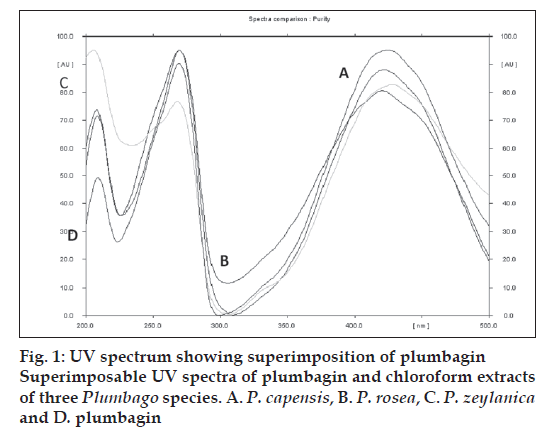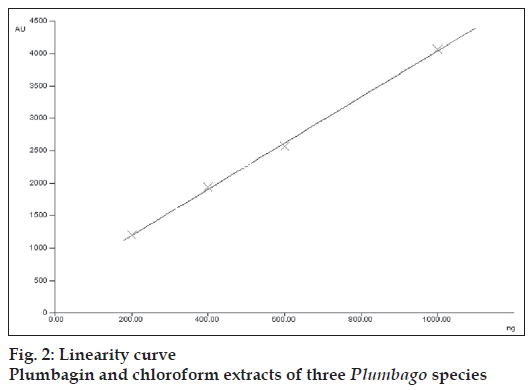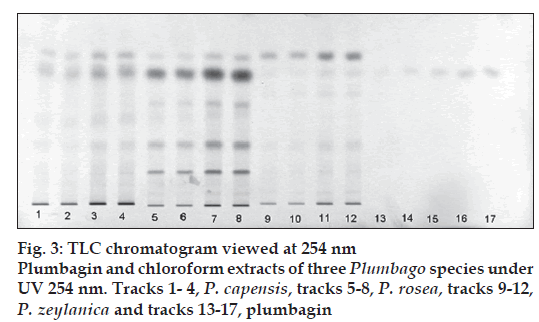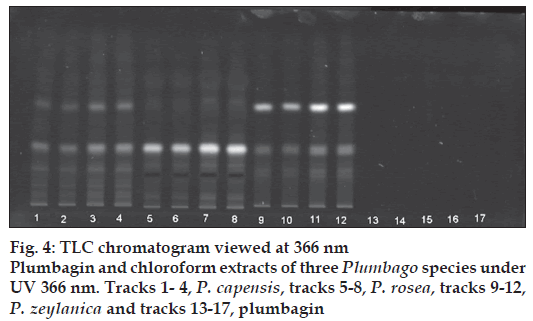- *Corresponding Author:
- A. Saraswathy
Captain Srinivasa Murti Drug research Institute for Ayurveda and Siddha (CCRAS), Anna Hospital Campus, Arumbakkam, Chennai-600 106, India
E-mail: saraswathy20042000@yahoo.co.in
| Date of Submission | 23 April 2009 |
| Date of Revision | 26 October 2009 |
| Date of Acceptance | 31 December 2009 |
| Indian J Pharm Sci, 2010, 72 (1): 86-91 |
Abstract
Physicochemical parameters of roots of three Plumbago species, Plumbago capensis, P. rosea and P. zeylanica belonging to Plumbaginaceae were analyzed. Microbial contamination, aflatoxins, pesticide residue and heavy metal content were also determined. Attempt has also been made to estimate the biologically active chemical plumbagin present in them and the data compared. The study ensures that the quality control parameters do help in the proper standardization of the crude drugs in drug development process for global acceptance.
Keywords
P. rosea, P. zeylanica, plumbagin, Plumbago capensis, quality control parameters, Root
Standardization of raw drugs in herbal industry is an important step towards quality control. Several analytical parameters such as physico–chemical constants, estimation of elements, heavy metals, microbial contamination, aflatoxins and pesticide residue are to be carried out as a measure of quality check. The World Health Organization [1] emphasized certain quality standards and has proposed certain guidelines for the assessment and development of standard herbal products. The plant Plumbago zeylanica of Plumbaginaceae known as Chitraka/ Chitramoolam is a popular drug in Ayurveda and Siddha [1]. It finds place in several of the compound formulations of these systems of medicine, as one of the ingredients [2,3]. In times of scarcity of P. zeylanica roots, the roots of the related species namely P. capensis and P. rosea, which are indigenous to India are often used. The roots of three species are recognized due to the presence of naphthaquinones namely plumbagin and its derivatives. The roots of P. rosea and P. zeylanica have been evaluated for activities [4,5]. The paper deals with the physico-chemical standards such as loss on drying at 105°, ash, acid-insoluble ash, water soluble ash, crude fibre content, alcohol soluble extractive, water soluble extractive, analysis of heavy metals and other elements, pesticide residues, aflatoxins, microbial contamination and assay of plumbagin through HPTLC for the roots of three Plumbago species.
Materials and Methods
Roots of P. capensis were procured from the local market at Nagercoil, Tamil Nadu. Roots of P. rosea and P. zeylanica were collected from Erode and Arakonam near Chennai, Tamil Nadu, respectively. The crude drugs were identified at Captain Srinivasa Murti Drug Research Institute for Ayurveda and Siddha (CCRAS), Arumbakkam, Chennai, India. Voucher specimens of P. capensis (00583), P. rosea (00502) and P. zeylanica (00518) have been deposited in the herbarium of this institute.
The procedures recommended in WHO guidelines [6], Indian Pharmacopoeia [7] and AOAC [8] were followed to determine loss on drying at 105°, total ash, watersoluble ash, acid-insoluble ash, alcohol soluble, water soluble extractive contents, analysis of heavy metals and other elements, afl atoxins, pesticide residues.
The roots of the plants were given a quick wash with water, shade dried and coarsely powdered. The powdered samples were weighed (each 1 g) into separate conical fl asks and treated with 5 ml of concentrated nitric acid. The fl asks were covered with watch glasses and heated for an hour; the contents of the fl asks were treated with additional 5 ml of nitric acid, followed by 2 ml of 30 % hydrogen peroxide solution. The heating was continued till the clear solution was obtained. The mixture was diluted with deionised water and filtered through Whatman No. 42 filter paper and the solutions were made up to 50 ml [9].
Afl atoxins were determined by Kobra cell technique using Agilent HPLC instrument as per the method ASTA [10]. Pesticide residues were analyzed using GC-MS Agilent instrument equipped with mass selective detector as per the method AOAC [8]. For determination of microbial load, 1g of each sample was weighed accurately in separate flasks and 99 ml of sterile distilled water was added. The samples in the flask were kept in a mechanical shaker for few minutes to obtain uniform suspension of microorganisms. The dilution is 1:100 or 10-2 from, which 1 ml was transferred to 9 ml of sterilized distilled water to make a 1:1000 dilution and this procedure was repeated up to 10-6 dilution. Each 0.1 ml of serially diluted sample was inoculated to the sterile plates containing nutrient agar, SS agar and potato dextrose agar (PDA) by spread plate method. Nutrient agar and SS agar plates were incubated at 37º for 24 h and PDA plates were incubated at room temperature for 3-5 days. Bacterial and fungal colonies were counted using a colony counter [6].
For the estimation of plumbagin, 1 g of each of coarsely powdered root samples of P. capensis, P. rosea and P. zeylanica were weighed accurately and extracted exhaustively with chloroform (50 ml) in a Soxhlet apparatus. The chloroform extract was filtered, concentrated and made upto 5 ml in volumetric flask [11-15]. The standard solution was prepared by dissolving 10 mg of plumbagin in 10 ml of chloroform. From this stock solution, 1 ml was pipetted out into a 10 ml standard flask and made up to the mark. Sample solution of the roots of P. capensis 5 μl, P. rosea 5 μl and P. zeylanica 10 μl and different concentrations of standard solution varying from 2 to 10 μl of plumbagin were applied on aluminium plate precoated with silica gel 60F254 0.2 mm thickness on different tracks as 6 mm bands by a Camag Linomat applicator V. The plate was developed in a twin trough glass chamber presaturated with toluene:ethyl acetate (4:1) and allowed to run upto a distance of 8 cm. After air drying, the plate was visualized under UV at λ 254 and 366 nm and scanned using scanner 3. Calibration graph was obtained with plumbagin ranging from 200 to 1000 ng (correlation coefficient, r= 0.99946).
Results and Discussion
Table 1 summarizes the various physico-chemical constants observed for the roots of three species. The physico-chemical analysis indicated the ash content of 2.62% in P. capensis, 8.01% in P. rosea and 3.1% in P. zeylanica, respectively which is due to the presence of inorganic matter present in these Plumbago species. Inorganic matter was found to be higher in P. rosea than P. zeylanica, whereas it was found to be less in P. capensis. Acid-insoluble ash indicates the presence of more siliceous matter in the drug. It was found to be 0.68% in P. capensis, 1.16% in P. rosea and 0.96% in P. zeylanica. More siliceous matter was found in P. rosea than P. zeylanica and it was noticed to be less in P. capensis. The alcohol soluble extractive reveals the presence of polar compounds like anthraquinones, alkaloids, glycoside of fl avonoids, steroids and triterpenoids present in the plant materials. It was seen to be 9.14% in P. capensis, 5.57% in P. rosea and 12.83% in P. zeylanica. The water soluble extractive reveals the presence of water soluble matters such as sugars, carboxylic acids, vitamins and amino acids and it was found to be 14.67% in P. zeylanica, 13.18% in P. capensis and 5.57% in P. rosea. Both the alcohol soluble extractive and water soluble extractive are higher in P. zeylanica, followed by P. capensis and P. rosea (P. zeylanica>P. capensis>P. rosea). Loss on drying at 105o is determined since the presence of excess moisture is conducive to the promotion of mould and bacterial growth, and subsequently to deterioration and spoilage of the drug. The moisture content was calculated to be 8.66% in P. rosea, 8.18% in P. zeylanica and 8.11% in P. capensis (P. rosea>P. zeylanica>P. capensis). Crude fibre consists largely of cellulose and lignin (97%) plus some mineral matter. It represents only 60 to 80% of cellulose and 4 to 6% of lignin. It is useful as a measure of nutritive value of animal feeds and also in the analysis of various foods and food products to detect adulteration, quality and quantity. The fibre content was accounted to be 14.30% in P. zeylanica, 12.51% in P. capensis and 9.79% in P. rosea (P. zeylanica>P. capensis>P. rosea). The data evolved can be considered for laying down the pharmacopoeial standards for the roots of the three Plumbago species.
| Parameter | P. capensis | P. rosea | P. zeylanica |
|---|---|---|---|
| (% w/w) | (% w/w) | (% w/w) | |
| Loss on drying at 105° | 8.11 | 8.66 | 8.18 |
| Total Ash | 2.62 | 8.01 | 3.11 |
| Water-soluble ash | 1.89 | 6.01 | 2.27 |
| Acid-insoluble ash | 0.68 | 1.16 | 0.96 |
| Alkalinity of water | 0.2 ml/g | 0.3 ml/g | 0.2 ml/g |
| soluble ash | |||
| Alcohol-soluble | 9.14 | 5.57 | 12.83 |
| extractive | |||
| Water-soluble | 13.18 | 10.85 | 14.67 |
| extractive | |||
| Crude fibre content | 12.51 | 9.79 | 14.30 |
Values are mean of 3 readings
Table 1: Physico-Chemical Values For plumbago Species
The different inorganic elemental content present in the plant part studied are shown in Table 2. Iron is the most indispensable metal to humans and its deficiency is characterized by anemia. The root of P. rosea contained significant amount of iron which is diuretic, demulcent and useful in the treatment of dysentery and croup [16]. Copper deficiency is characterized by chronic or recurrent diarrhea, low resistance to infection and anemia [17,18]. The maximum concentration of copper was found in P. zeylanica, which may be used to cure anemia, rheumatism and emetic conditions. Manganese is essential for haemoglobin formation. It is essential for growth, reproduction and skeleton development in humans [19,20]. The maximum concentration of manganese was observed in P. zeylanica>P. rosea>P. capensis, which are used in skin diseases, scabies, piles and rheumatism [21,22]. Zinc is a component of many metalloenzymes and also a membrane stabilizer and a stimulator of the immune response [23,24]. Its deficiency leads to loss of appetite, and impaired immune function. In more severe cases, zinc deficiency causes hair loss, diarrhea, delayed sexual maturation, impotence, hypogonadism in males, and eye and skin lesions [25,26]. The zinc content was high in P. zeylanica while the amount is almost equal in P. capensis and P. rosea, which may be useful in skin diseases and rheumatism.
| Sample | Fe | Cu | Mn | Ni | Zn | Co | Cr | Na | K | Ca |
|---|---|---|---|---|---|---|---|---|---|---|
| P. capensis | 5.86 | 0.42 | 0.55 | 0.03 | 0.34 | 0.06 | 0.02 | 94 | 89 | 42 |
| P. rosea | 6.47 | 0.22 | 0.92 | 0.01 | 0.34 | 0.06 | 0.00 | 82 | 113 | 18 |
| P. zeylanica | 2.92 | 0.47 | 1.17 | 0.02 | 0.51 | 0.09 | 0.00 | 80 | 89 | 24 |
| Values in ppm | ||||||||||
Table 2: Inorganic Mineral Analysis Of Plumbago Species
Chromium plays a vital role in metabolism of carbohydrates and its deficiency leads to diabetes in human body. Chromium deficiency leads to hyperglycemia, growth failure, cataract and arteriosclerosis [27-29]. The maximum content of chromium was seen in P. capensis followed by P. zeylanica and P. rosea which justified the use of the root in Ayurveda and Siddha systems of medicines for diabetes.
Sodium is involved in intracellular and extracellular fluid balance and the maintenance of the viscosity of blood [29,30]. Sodium plays an important role in the transport of metabolites. The maximum content of Sodium was seen in P. capensis followed by P. rosea and P. zeylanica. Potassium is a diuretic. Both sodium and potassium take part in ionic balance of the human body and maintain tissue excitability [29]. The maximum content of Potassium was seen in P. rosea. Calcium plays an important part in nerve-impulse transmission and in the mechanism of neuromuscular system [29]. Calcium content was in the order of P. capensis>P. zeylanica>P. rosea (Table 2).
The contents of heavy metals namely lead, mercury, cadmium and arsenic are found to be within the permissible limit [31] for the three Plumbago species, indicating that the three roots are safe to utilize as drugs (Table 3). The report of analysis for aflatoxins in the three Plumbago species is given in the Table 4. The aflatoxins B1, B2, G1, and G2 were below the detecting level revealing that they are free from toxins and are safe for internal use. Further the studies indicated that the absence of these aflatoxins would help to increase in shelf life of the raw drug. The various pesticide residues such as α,β,γ,δ-hexachlorocyclohexane (α,β,γ,δ-HCH), o,p’-dichlorodiphenyl trichloroethane (o,p-DDT), p,p’-dichlorodiphenyltrichloroethane (p,p’-DDT), o,p-dichlorodiphenyl dichloroethylene (o,p-DDD), p,p-dichlorodiphenyldichloroethylene (p,p-DDD), α-endosulphan, β- endosulphan, o,p-dichlorodiphenyldichloroethane (o,p-DDE) and p,p’-dichlorodiphenyldichloroethane (p,p-DDE) are analyzed. None of the above pesticides is detected (DL: 0.01 ppb) in the three Plumbago species, indicating that they are safe for their usage as drugs (Table 5). Analysis for the microbial load for the three Plumbago species is found to be within the limit of WHO guidelines, indicating that they are free from pathogens and can be used as drugs (Table 6). TLC studies revealed that the solvent system toluene:ethyl acetate (4:1) was ideal and gave a single spot with Rf 0.70 for plumbagin and well resolved spots for the test samples. The identity of plumbagin in the samples was shown by superimposable UV spectra (fig. 1) at Rf 0.70 in the sample solutions. The peak purity data is given in Table 7. The linear regression curve of plumbagin was obtained for the amount of 200 to 1000 ng. The sample solutions also showed plumbagin within this curve as shown in fig. 2. The spots of the chromatogram were visualized under UV at λ 254 and 366 nm were shown in figs. 3 and 4. The amount of plumbagin was calculated from the linearity curve. The percent content of plumbagin was found to be in the decreasing order of P. rosea (0.17), P. capensis (0.04) and P. zeylanica (0.01). The physicochemical parameters evaluated are useful in standardization of the roots of the three species. Heavy metals, aflatoxins, pesticidal residue and microbial load for the three Plumbago species are found to be within the limit of WHO guidelines, indicating that they are free from pathogens and they are safe to be used in ISM. The data obtained from the study would be useful in the identification of the roots of these Plumbago species and serve as standards. Quantification of the marker compound, plumbagin done by HPTLC is found to be in the order of P. rosea>P. capensis>P. zeylanica, which can also be considered as an additional parameter for quality check of these three roots. P. rosea is found to contain the highest (0.17% w/w) of plumbagin. The data evolved can be considered for laying down the pharmacopoeial standards for the roots of the three Plumbago species.
| Element | P. capensis | P. rosea | P. zeylanica | Permissible Limits |
|---|---|---|---|---|
| As | 0.0002 | 0.0001 | 0.0001 | 3 |
| Cd | 0.0028 | 0.0007 | 0.0065 | 0.3 |
| Pb | 0.2359 | 0.3116 | 0.2605 | 10 |
| Hg | 0.0037 | 0.0053 | 0.0031 | 1 |
Values in ppm. Permissible limits are as per the Ayurvedic Pharmacopoeia of India, 2008
Table 3: Heavy Metal Analysis Of Plumbago Species
| Aflatoxins | P. capensis | P.rosea | P.zeylanica |
|---|---|---|---|
| Aflatoxin B1 | BDL (DL: 1.0 ppb) | BDL (DL: 1.0 ppb) | BDL (DL: 1.0 ppb) |
| Aflatoxin B2 | BDL (DL 0.5 ppb) | BDL (DL 0.5 ppb) | BDL (DL 0.5 ppb) |
| Aflatoxin G1 | BDL (DL 1.0 ppb) | BDL (DL 1.0 ppb) | BDL (DL 1.0 ppb) |
| Aflatoxin G2 | BDL (DL 0.5 ppb) | BDL (DL 0.5 ppb) | BDL (DL 0.5 ppb) |
BDL denotes below detectable limit and DL detectable limit
Table 4: Aflatoxins In Three Plumbago Species
| Pesticides | P. capensis | P. rosea | P. zeylanica |
|---|---|---|---|
| α – HCH | ND | ND | ND |
| β - HCH | ND | ND | ND |
| γ – HCH | ND | ND | ND |
| δ –HCH | ND | ND | ND |
| op-DDT | ND | ND | ND |
| pp-DDT | ND | ND | ND |
| op-DDE | ND | ND | ND |
| α- Endosulfan | ND | ND | ND |
| β - Endosulfan | ND | ND | ND |
| op-DDD | ND | ND | ND |
| pp-DDD | ND | ND | ND |
Detection limit is 0.01 ppm, ND denotes not detectable and DL detectable limit
Table 5: Pesticidal Residue Analysis Of Three Plumbago Species
| Name of bacteria | CFU | WHO limit | Inference | ||
|---|---|---|---|---|---|
| P. capensis | P. rosea | P. zeylanica | |||
| Eschericha coli | 2×101 | 8 | - | 102 | Within the limit |
| Salmonella sp. | - | - | - | Absence | complies |
| Shigellasp. | - | - | - | Absence | complies |
| Enterobactersp. | - | - | - | 104 | complies |
| Total bacterial count | 12×102 | 18×103 | 9×102 | 107 | Within the limit |
| Yeast &Mould | 1×102 | 10×101 | 13×102 | 104 | Within the limit |
| CFU denotes colony forming unit | |||||
Table 6: Determination Of Microbial Load For Three Plumbago Species
| Sample | Rf | r(s,m) | r(m,e) |
|---|---|---|---|
| P. capensis | 0.69 | 0.9998 | 0.9992 |
| P. rosea | 0.68 | 0.9999 | 0.9996 |
| P. zeylanica | 0.69 | 0.9999 | 0.9998 |
| Plumbagin | 0.70 | 0.9999 | 0.9996 |
Table 7: Peak Purity Test
Acknowledgements
I thank the Vice Chancellor of SASTRA University for encouraging me to do the research work. My thanks go to DST for financial assistance during the research work.
References
- Mudaliyar CS. Siddha Materia Medica. Part I, 6th ed. Chennai: Medicinal Plants division Department of Indian Medicine and Homeopathy; 2002. p. 381-6.
- The Ayurvedic Pharmacopoeia of India.1st ed. Part I, Vol. 2. New Delhi: The Controller of Publications; 1989. p. 29.
- The Siddha Formulary of India. 1st ed. Part I, New Delhi: The Controller of Publications, 1992. p. 177-83.
- Saraswathy A, Pradeep RV, Muralimanohar B, Vairamuthu S. Wound Healing activity of the chloroform extract of Plumbago rosea Linn. and plumbagin. Nat Prod Sci 2006;12:50-4.
- Veluri R, Diwan PV. Phytochemical and Pharmacological aspects of Plumbago zeylanica. Indian Drugs 1999;36:724-30.
- World Health Organization; Quality Control Methods for Medicinal Plant Materials. Geneva: WHO Publications; 1998. p. 10-31.
- Indian Pharmacopoeia. 4th ed. Vol.2. New Delhi: The Controller of Publications; 1996.
- Horwitz W, Latimer GW, editors. Official Methods of Analysis of AOAC International. Chapter 10. 18th ed. Maryland: AOAC International; p. 18-23.
- Sahito SR, Kazi TG, Kazi GH Jakhrani MA, Shaikh MS. Trace elements in two varieties of Indigeneous Medicinal Plant Catharanthus roseus. Sciences 2001;1:74-7.
- Official Analytical Methods of the American Spice Trade Association. 4th ed. New Jersey: ASTA, Inc.; 1997. p. 149-52.
- Gupta AP, Verma RK, Gupta MM, Kumar S. Estimation of plumbagin using High Performance Thin Layer Chromatography. J Med Aro Plant Sci 1999;21:661-3.
- Upadhya UM, Ravishanker MN, Padh H, Goyal RK. HPTLC fingerprint profile of an aqueous extract of Enicostemma littorale. J Med Aro Plant Sci 2003;25:675-81.
- Wagner H, Bladt S. A Thin Layer Chromatography Atlas. In Plant Drug Analysis. 2nd ed. Berlin: Springer-Verlag; 1996.
- Sethi PD. High performance thin layer chromatography. New Delhi: CBS Publisher and Distributors; 1996.
- Reich E, Schibli A. High performance thin layer chromatography for the analysis of medicinal plants. New York: Theme Medical Publishers; 2007.
- Beutler E, Blaisdell RK. Iron enzymes in iron deficiency: V: Succinic dehydrogenase in rat liver, kidney and heart. Blood 1960;15:30.
- Hawkins WW. Iron, copper and cobalt. In: Beaton GH, McHenry EW, editors. Nutrition: A comprehensive treatise. New York: Academic Press; 1964. p. 309.
- Adelstein SJ, Vallee BL. Copper. In: Comar CL, Bronner F. editors. Mineral metabolism: An advanced treatise. Vol. II. Part B. New York: Academic Press, 1962. p. 371-401.
- Underwood EJ, Mertz W. Trace elements in human and animal nutrition. New York: Academic Press, Inc; 1987. p. 185-215.
- Loberg MD, Corder EH, Fields AT, Callery PS. Minerals and your health. J Nucl Med 1980;20.
- Atukorala TM, Waidyanatha US. Zinc and copper content of some common foods. J Nat Sci 1987;15:61-9.
- Sandstead HH. Understanding zinc: Recent observations and interpretations. J Lab Clin Med 1994;124:322-7.
- Hambidge KM. Zinc as membrane stabilizer. J Hum Nut 1978;32:99-100.
- Solomons NW. Mild human zinc deficiency produces an imbalance between cell-mediated and humoral immunity. Nutr Rev 1998;56:27-8.
- Maret W, Sandstead HH. Zinc requirements and the risks and benefits of zinc supplementation. J Trace Elem Med Biol 2006;20:3-18.
- Prasad AS. Zinc deficiency: Its characterization and treatment. Met Ions Biol Syst 2004;41:103-37.
- Jamal H, Raza H, Janua KM, Bhatty MK. Effect of minor minerals containing chromium on human health. Pak J Sci Ind Res 1986;29:45-7.
- Saner G, Yuksel T, Gurson CT. Effect of chromium on insulin secretion and glucose removal rate in the new born. Am J Clin Nutr 1980;33:232-35.
- Indrayan AK, Sharma S, Durgapal D, Kumar N, Kumar M. Determination of nutritive value and analysis of mineral elements for some medicinally valued plants from Uttaranchal. Curr Sci 2005;89:1252-5.
- Kar A, Choudhary BK. Important mineral content of a few Ayurvedic herbs with a discussion on medicinal aspects. Indian Drugs 1994;31:127-30.
- The Ayurvedic Pharmacopoeia of India, Part II, New Delhi: Ministry of Health and Family Welfare; 2008. p. 168.








